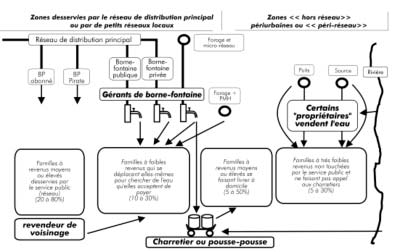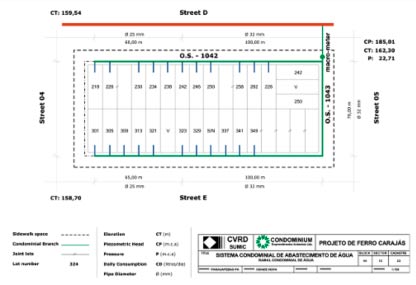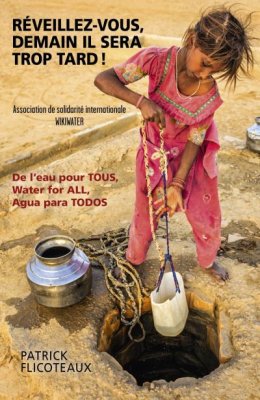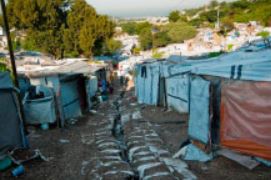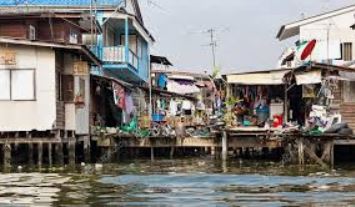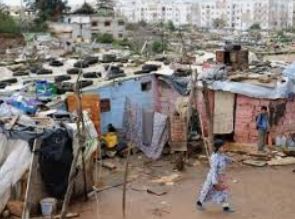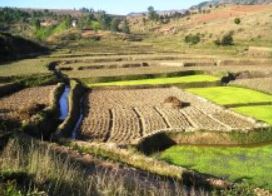1) What is involved?
After first restating the main issues that arise in precarious and informal habitat or shanty town areas, restating the difficulties faced and especially the technical, social, legal or governance means that can facilitate access to water by the residents of these areas.
For issues that are specific to sanitation, please refer to Factsheet A 16.
2) What is meant by precarious habitat, informal habitat and shanty town areas?
Their definitions vary by author and by country. The most often used definitions are as follows :
- An informal habitat area is a dense collections of sordid buildings or shanties put up without any official sanction on public or private land, generally located around cities.
- A precarious habitat is one of temporary buildings, generally squalid and resembling a shanty, but not necessarily located in an informal habitat area.
- A shanty town is a densely built-up, run-down and most often unofficially sanctioned area (but not necessarily so, as some that have been in place for a long time in the most impoverished parts of towns may have finally gained recognition from some authorities, hence tolerance so that water pipes can now reach them).
For UN-Habitat, a shanty town is a place where the run-down substandard accommodation does not ensure their occupants proper protection against bad weather conditions, does not offer enough space (with more than three people per room), away from a point of access to water at affordable cost and without even toilets close by and offering no tenure security to protect inhabitants from expulsions.
All of these kinds of habitat can further be encountered in the same city or neighbourhood for the technical, social and economic conditions of neighbouring locations may vary considerably and this does not make it any easier to find solutions to these problems.
This means that, first and foremost, before undertaking any project to impact such an area, completing an in-depth study into these conditions as well as into its socio-cultural context, into the expectations of the local population who must be considered as able to play a part in their own development, and into the local leaders, both in terms of assessing the situation but also to choose the technology and governance choices to be made.
For greater ease of understanding, in this Factsheet we will use the common term of “shanty towns” to designate each of these kinds of habitat.
3) The shanty town problem

Credit : Gado WSP 
In developing nations, a considerable share of the urban population (over 950 million people, or almost one third of the world’s urban population according to UN Habitat), in this the century of smartphones and tablet computers, in squalid neighbourhoods with only very limited access to basic services. Most of the time, the provision of drinking water and sanitation for these neighbourhoods is inadequate or even almost non-existent, or costs far too much for the poor populations who live there.
The sanitation situation is unfortunately even worse than that of water and leads to many illnesses as well as making life easy for epidemics. One of Africa’s largest shanty towns, that of Kibera (in Nairobi) has even been nicknames the “flying toilets” shanty town as many inhabitants throw their excrement out of the windows in plastic bags for lack of toilets…
These issues are aggravated by the often uncontrolled and rapid population growth and urban sprawl found in developing nations.
Although happily, according to the United Nations, 227 million people were able to leave shanty towns during the last 12 years, the number of people still living in them rises by some 10% every year and may well, according to UN Habitat, hit three billion by 2050 if nothing is done…
Yet, major city authorities and the major water utilities that they sometimes contract out water production and distribution to are unable to meet rising demand and in many cases do not have the political willingness to take on this crisis situation.
So, what is to be done?
What part can the population play in such situations and how can they organise themselves to meet such challenges ?
What often happens in practice, for lack of a better solution, is that many small private or even informal operators, who are in practice unavoidable, resell the water that is essential to individuals, at prices often far higher than that of the water provided by a connection to the municipal or utility company supply. How can we avoid this paradox where water actually costs 30 to 50% more, and sometimes far more than that, in shanty towns. How can we stop poor populations from paying far more than richer ones ?
This is the purpose of this Factsheet and the various envisageable solutions or lines of thought.
It should however be stated right away, that the true solution to these problems is not a technical or financial one, for most often the need is to respond to a shortage of water resources or administrative, technical or financial obstacles that cannot be avoided but that are truly political in nature.
The current unbearable situation is essentially :
- Caused by lack of political will on the part of the local, regional or national authorities who abandon these issues in favour of other simpler or more prestigious activities, and
- Sometimes also, due to a lack of enthusiasm on the part of local water utilities who prefer to invest in areas that are more solvent or profitable or that hesitate to invest without permission or financial support from the authorities that have entrusted them with managing the service.
4) Why do public water distribution networks often not reach poor suburban neighbourhoods or shanty towns?
Building or extending a water network, or a sewage network for that matter, in poor areas where the population is also growing very rapidly and were frequent extension are required, is often no easy task.
- First of all, there are often serious technical difficulties or constraints dues to topographical aspects and to the geographical characteristics of the areas, with a lack of roads, an imbroglio of alleyways and homes, winding narrow passages, limited public space that is accessible for laying pipes, severe slopes or gradients, as in the hillside “favelas” of Rio de Janeiro or in Port au Prince or simply because of very high density housing.
- Furthermore, these areas are often considered as illegal by the authorities. As the inhabitants have no land titles, governments or municipalities most often do not wish to see :
- The arrival of a water or electricity supply becoming a more or less tacit recognition of any right to live there,
- Any recognition of rights granted these inhabitants, and this despite the recent enactment by the United Nations General Assembly in 2011 of a right to water, as a public service, for fear especially of attracting even more people and not being able to make them leave again, e.g. when undertaking a real estate restructuring or construction project.
For their part, the private utilities that manage the service do not wish to, or cannot, afford confrontation relations with the municipal authorities in charge and further fear the destruction of any infrastructures that they may build in the event of any expropriation that may take place.
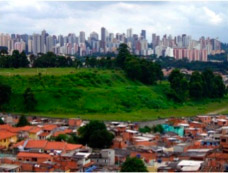
A suburban shanty town in São Paulo (Brazil). Source : Wikipedia 
They therefore generally consider as especially risky, any investments made in poor areas that are unofficial, anarchic and unplanned and especially in shanty towns, all the more so if the municipality does not wish to make any financial effort of their own. Additionally, as the price of water needs to be adapted to suit the income of the inhabitants, utilities prefer to invest in better off neighbourhoods, thereby guaranteeing that their investment will pay off better and be less risky in terms of bill collection.
Those utilities that nevertheless do bring water to these areas most often concentrate their efforts on creating public standpipes to provide supplies for a fee or for free or water kiosks but they also make as many private connections as possible for greater comfort but also to balance their books and make money from the operation. The cost of these connections is a high one and may represent the equivalent of many month’s income. Unfortunately, the poorest families do not have the financial means to bear this cost which remains an unaffordable one for them.
We do however note that major utilities have recently, often with World Bank aid, started to add specific plans for lower cost “social” connections to their programs, combined with soft credit terms or long term spreading of connection costs, as is the case in Morocco or Algeria.
Lastly, we should state that :
- Situations often vary considerably from one shanty town to another and sometimes even from one neighbourhood to another, both from a technical but also a social or economic point of view.
- Fairly often, there are two different categories of informal precarious habitats :
- Groups of precarious habitats or shanties built spontaneously and most often with no property or rental rights, by people who have left the countryside or fled absolute misery. These are sometimes called “squatter settlements” as is the case in India,
- Areas of now old and also unsanitary shanties, but where the occupation status has perforce become accepted and been legalised by the authorities, often with the hope that later on, as part of urban development plans, it will become possible to build new neighbourhoods. These areas are sometimes called “slum areas” and are slightly better treated by municipal authorities.
5) The main technical means for carrying water
a) Prolonging the city’s public water network into the shanty town
This doubtless ideal solution, is seldom applied for the administrative, financial and often political reasons already set out as well as for technical reasons linked to disorganised configuration and high population density in these precarious habitat areas.
b) Prolonging the city’s public water network only to the gates of the shanty town or its borders
This is a frequent solution with three variants :
It comprises running pipes up to the informal habitat areas and :
- Installing “water kiosks” where the pipes arrive, i.e. bulk water supply points managed and maintained by small scale private operators or neighbourhood communities who then, must often with the help of the local population, install mini-network buried at a shallow depth, and sometimes even in the open air, using pipes to supply standpipes made available for free or at a cost, depending on cities or regions, or collective hook-ups used by multiple families or even some private hook-ups on a fee paying basis,
- Installing lifting pumps on the ends of the supply pipes, pumps that are able to increase the mains pressure and send water uphill to public standpipes when the shanty town is built on a hillside or above a city or town, as is often the case,
- Allowing the mains supply to be extended by true simplified but well suited networks, so-called “condominium” networks, i.e. properly structured but built to simpler standards and managed by small local private operators or by neighbourhood committees, or even by an agreement between a number of owners or users who make available their land or entrance ways for running pipes and making hook-ups.
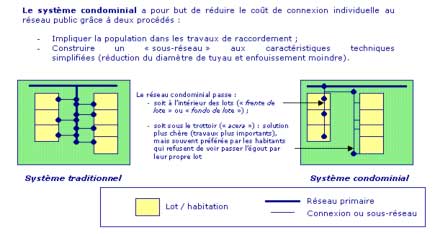
Source : Nomadeis “Aqua tu penses” www.nomadeis.com 
c) Prolonging the city’s public water network with large pipes to the gates of the shanty town, but then running smaller pipes right up to public standpipes.
This solution is an oft-used one, for it is easier and cheaper, but not as handy for the inhabitants who only have access to a few standpipes where it is often necessary to queue up for water.
6) The main means used for distributing water to those who do not have a private hook-up
In those, most numerous, neighbourhoods where there are no private hook-ups to most homes, there are a number of substitute modes of water distribution : standpipes, sometimes springs or family wells or wells shared with neighbours and rain water collection, but there are especially the many small private water carriers and sellers and small private operators of water kiosks, drillings fitted with hand pumps.
These various distribution modes are more or less extensively developed depending on the region and sometimes even depending on the various neighbourhoods within a shanty town. Most often they are run not by town or city authorities, who most often ignore them, but rather by associations or neighbourhood management committees or by small scale private operators who sometimes take excessive advantage of the situation by charging 30 or 50% more than the price of the water brought by the public municipal network, and sometimes even more than that.
In practice, low income users often make a choice every day between the various water supply methods on offer, basing their choice on their available financial resources as well as on the time available to the family (who may be employed on a more productive task) as well as on the availability of water on offer that day from the various providers (and which may vary depending on the rains, pressure drops or the often frequent cuts in water supplies, for example).
a) Standpipes
Standpipes are one of the main ways to supply homes that do not have a private hook-up. They can be found pretty much everywhere, especially in India and Africa. Generally, they take the shape of a collective water point connected to a simplified and small scale network.
Standpipes are especially welcomed by the poorest users, for this kind of service lets them purchase water in small quantities thereby spreading out their spending. In some countries, e.g. in India, with exceptions like Mumbai (formerly Bombay), standpipes offer free or very low cost water.
Unfortunately standpipes are sometimes not reliable and handy enough with drawbacks, including short operating periods, sometimes lasting only a few hours every day, requiring users to resupply at night and insufficient water pressure, all of which may lead to long queues.
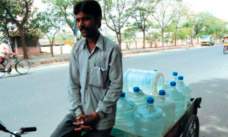
Transporteur d’eau en Inde. Photo WSP
b) Water carriers
A number of different kinds of water carriers exist, for example :
- Water carriers on foot, still often found in very poor towns like Port-au-Prince, Haiti,
- Water carriers on bicycles, motorcycles or three wheelers,
- Pushcarts, small carts fitted with two arms that can carry 100 to 200 litres of water. They are very widespread, for example in Ouagadougou (Burkina Faso) and Conakry (Guinea).
- Animal drawn carts, often used in the major towns of the Sahel,
- Tank vans or trucks.
Delivering water to the home also meets the needs of the poorest families, namely purchasing small quantities of drinking water (4 to 20 litres per person per day) when they need it and when they have enough money to pay for it while letting them use their time for other activities and looking for work.
It is also useful to other levels of society and categories of residents living in areas where the distribution network is not sufficiently developed.
The price of this water sold to the home ranges in price between the equivalent of $2 to $6 per cu. metre (the water is actually sold by the litre), whereas the water sold from the standpipes in the same towns is far less expensive, often ranging from $0.60 to $1.50 per cu. metre. Nevertheless, this price differential should not always be considered completely abusive after making allowance for the small quantities transported by a carrier every day (except when using a tank truck), the harshness of their work in the heat and on rough uneven streets and well as based on the time spent.
Their role is in any case most often an essential one that is useful to many cities and towns and to some degree to the inhabitants who prefer to save their time and strength rather than use it to get water.
Carrying water by tank truck is mainly used to supply major users who have storage tanks.
c) Neighbourhood water sellers
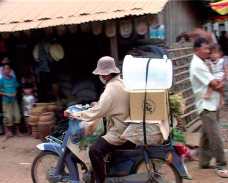
Photograph by SDC Swiss Aid
In this case, better off families who have a private hook-up may sell water to some of the homes in their neighbourhood. In most towns and cities, these sellers are not recognised and may often be considered to be illegal tradesmen.
They set their own prices and sometimes turn it into an easy and lucrative trade that may lead to abuse, but they sometimes offer this possibility of making themselves useful to their neighbours or friends.
Note that in some towns as in Côte d’Ivoire, this system has actually been encouraged and regulated by the water utility that has implemented special “commercial” water contracts.
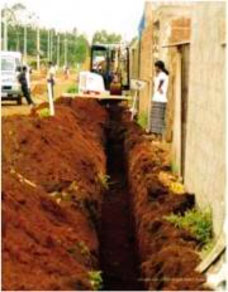 d) Small private networks
d) Small private networks
Small private networks are networks set up by individuals investing their own money. These networks may be independent of the main network and take water from a well or they may be hooked-up to a main or secondary supply network. These small networks tend rather to supply private standpipes and not private hook-ups. The standpipes supplied by these networks often offer a better quality service in terms of water pressure available and opening times, even if the water costs more.
e) “Condominium” water distribution
As stated before, so-called “condominiums” are a way of envisaging an organised extension to regular water mains so that they can reach suburban neighbourhoods. The cost of installing and maintenance these extensions is shared by a group of inhabitants just like any joint form of ownership, hence the name. The main advantage of any such extension is that the pipes run through the private property held by families who are members of the condominium. Hence network sizing does not have to meet official constraints or standards set out for pipes that pass under public roads.
This especially reduces the depth required when burying pipes, the diameter and the length of pipes and makes it easier to maintain the installations. Consequently, this leads to installation and maintenance costs that are often more than 30% lower.
User involvement in financing and also in fitting these installations also leads to a feeling of responsibility and therefore better infrastructure usage.
To sum up, the means for serving an informal habitat or shanty town area with a water supply can for the most part be illustrated as follows :
7) The main kinds of governance and management for installations
This point is one of the most important ones for it often conditions the success or the failure of a programme to supply a shanty town with water.
There are various kinds of governance, but experience tends to show that, for lack of a better approach, and especially given the very small number of towns or cities that are willing to expand their public water supply networks into these least affluent and precarious communities, despite this being the preferred solution sooner or later, the best solution at least temporarily is to entrust a management role to small local public or private operators overseen by the town or city, or to community groups of neighbourhood residents with whom agreements are made.
a) Public management
This really should be the rule. For that matter, it in no way stops the relevant towns and cities from contracting out all or part of the water distribution service to neighbourhood committees or to small private distributors if they are, at least for now, the ones closest to the populations and the most effective in their field.
b) Having the whole network managed by major operators
This formula is a fairly frequent one in developed countries, where the authorities retain ownership of the installations and exercise control over the provision of service, but entrust management to the private operator of their choice after a contract is negotiated and signed. In recent years, this approach has suffered a number of failures, especially in Argentina, Bolivia and in the Philippines.
c) Participative or Community management
This comprises having installations managed, or more often letting community groups of residents from the same area or neighbourhood manage the installations themselves (most often after first taking the initiative of building and paying for them, for lack of any initiative on the part of the authorities).
Depending on historical factors or the local situation, these communities will then manage all or a part of the technical water delivery installations as well as the distribution services and the collection of fees that they set themselves.
These organisations are generally setup as neighbourhood committees, user group networks or management committees under various names and with a more or less well structured approach, but most often highly representative of the population and therefore very well accepted by them. They are generally led by recognized leaders and persons who are devoted to their task, but sometimes unfortunately they come under the control of less diligent individuals or donors who are far from unbiased or political parties seeking to anchor themselves in these neighbourhoods.
8) How to improve service to the poorest populations?
We have seen the various ways to do this. There are many, but there is no ideal solution, especially as the solution is often seriously dependent on the specific technical, but also socio-economic condition of the shanty towns and this sometimes varies across neighbourhoods as does their social cohesion and financial means.
It is therefore fundamental, before designing or proposing any program to talk to :
- The people in charge of these neighbourhoods or their leaders, who are sometimes completely dedicated to improving them but also sometimes out to make a name for themselves or have political views in mind,
- And also, local or city authorities so as to determine their position, their means, their projects and what possibilities there are for collaboration, but also to prompt them to act.
It is also necessary to not set targets that are too low or too ambitious, to consider that the situation is only a temporary one, but rather to take a medium or more or less long term view by already implementing more sophisticated installations, especially where a true desire for significant improvement has been observed on the part of certain residents or neighbourhoods and a certain “ability to pay”.
Contrary to the oft stated idea, there are not just people living in poverty in shanty towns, even if many are. This is because many work there, more work outside of them, and in some parts there is a certain “ability to pay” (otherwise, how could they pay for the high price services offered by small scale water carriers or distributors ?). Some residents are therefore willing to pay for a better quality service.
This, for example, is the case for those who wish to be able to obtain a private connection (especially when municipal authorities or utilities organise campaigns to install “social connections” under attractive financial conditions as detailed in Factsheet E 47), so that they can get access to water that is often of better quality, better supervised and at a far lower price, all without waiting.
Such initiatives will later on help to pull other population categories or other neighbourhoods upwards when, later on, they two have the necessary means.
Lastly, we should restate that it is really essential to ensure that local authorities take an interest in this issue, by encouraging and assisting them where necessary and taking care to include shanty town issues in their urban development plans.
Clearly, water distribution utilities in developing countries are unable to provide private hook-up for the entire population of the major urban centres. Due to technical, financial, economic or political obstacles coming in the way, it is impossible to keep up with the rate of urban growth seen in these countries.
Even if a private hook-up is the ultimate aim, it is a standard imported from developed nations. The influence of arguments like the taste of the water or supposed quality of the network on the choices made by poor families is often overstated compared with other factors like the price, the distance and the availability of water. Other options like private hook-ups are possibly better suited to, at least initially, meet the vital needs of these families.
Consequently it is essential that all of the players involved, especially local authorities and water distribution utilities :
- Better face up to their responsibilities,
- Acknowledge the importance of the complementing, but sometimes essential, role played by small independent operators,
- But especially, they need to ask for, and take into account, the feelings of the populations involved, by fully recognising their representative and assisting them in organising themselves and managing the installations themselves until they are able to do it themselves, which should rather be the rule.
Again, development policies aimed at ensuring water supplies to suburban areas need to take into account the specific needs of these neighbourhoods, without underestimating the benefits and the importance of community based management modes that have already largely proven themselves, or the current role of the smaller operators.
Regarding the latter point : recognising, legalising and organising these small operators as well as defining specific pricing policies for water carriers and resellers, are measures that can, at least a little, improve the water service provided to the least favoured areas while developing small businesses that create a few jobs and drive the local economy.
9) An implementation example: the condominium network in Paruapebas Brazil
In the 1990s, the town of Paruapebas in Northern Brazil faced very fast growth as a result of steel mining activities in the region. Since 1988, the town’s population increased five-fold and now exceeds 100,000. In the early 1990s, barely 1,000 people had an adequate drinking water supply while 5,000 had hook-ups to a mini-network pumping water from the local river without any treatment. Another 15,000 people could only count on poor quality water from wells, standpipes or tank trucks.
In 1993, a partnership with CVRD, the main mining operator active in the region and the municipal authorities allowed the town to secure a $7.8 million loan (later increased to $14.5 million) from the World Bank to cover the improvement of the town’s water and sanitation services. The original project called for building a capture system with a capacity of 230 litres per second, drawn from the river, a treatment plant, a 6,000 cu. metre water tank and conventional networks able to cover the water supply and sanitation needs of 90% of the population. By 1996, the water production and storage system had been completed, but it was clear that the remaining funds would be inadequate to build the planned networks. Consequently, CVRD reviewed the project and decided to redirect the project towards setting up condominium networks, something that was possible, ensuring that the project was completed without exceeding the original budget. This was because the study showed that this way, it would be possible to achieve savings of some 70% in the water networks (with a unit cost of $45 compared with $167 for a conventional network, while retaining the same installation characteristics, namely 90% coverage and 250 litres per person per day). A little over half of these savings came from lower network burial and labour costs, the rest from lower spending on pipes.
Diagram showing a condominium network for supplying water in Paruapebas. The main network is shown in red. Source : Melo, 2005 
Nevertheless, and despite the planned savings, the cost was still a prohibitive one. The solution that was found was to ask the population to take part in installing the hook-ups. A number of meetings at various levels were then needed to reach a consensus, clarify the project’s operation and goals and to mobilise the population. A pilot project was then undertaken as an example in one part of town to test concept acceptation. It proved the efficiency of the system in bringing water right to the poorest neighbourhoods and ensured support from the population. In the end, the programme was a great success and in Paruapebas improved the water service to 60,000 people organised into some 800 condominiums.
10) Where to obtain further information?
- Partenariat Eau et Assainissement en Afrique. Améliorer l’accès des populations urbaines démunies aux services d’eau et d’assainissement – Recueil de bonnes pratiques en Afrique Subsaharienne (Improving access by impoverished urban populations to water and sanitation services). A collection of best practices in Sub-Saharan Africa. Dakar, 2004. Available from : http://www.pseau.org/outils/ouvrage...
- COLLIGNON, B. ; VEZINA, M. Independent Water and Sanitation Providers in African Cities. Water and sanitation programme - World Bank, Washington, 2000. Available from : http://www.pseau.org/outils/biblio/...



